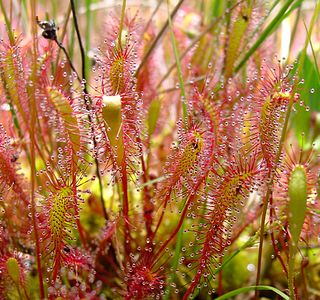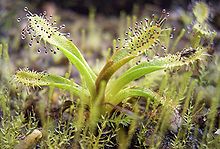
Drosera, which is commonly known as the sundews, is one of the largest genera of carnivorous plants, with at least 194 species. These members of the family Droseraceae lure, capture, and digest insects using stalked mucilaginous glands covering their leaf surfaces. The insects are used to supplement the poor mineral nutrition of the soil in which the plants grow. Various species, which vary greatly in size and form, are native to every continent except Antarctica.

Droseraceae is a family of carnivorous flowering plants, also known as the sundew family. It consists of approximately 180 species in three extant genera. Representatives of the Droseraceae are found on all continents except Antarctica.

Drosera capensis, commonly known as the Cape sundew, is a small rosette-forming carnivorous species of perennial sundew native to the Cape in South Africa. Because of its size, easy-to-grow nature, and the copious amounts of seed it produces, it has become one of the most common sundews in cultivation, and thus, one of the most frequently introduced and naturalised invasive Drosera species.

Drosera rotundifolia, the round-leaved sundew, roundleaf sundew, or common sundew, is a carnivorous species of flowering plant that grows in bogs, marshes and fens. One of the most widespread sundew species, it has a circumboreal distribution, being found in all of northern Europe, much of Siberia, large parts of northern North America, Korea and Japan but is also found as far south as California, Mississippi and Alabama in the United States of America and in New Guinea.

Drosera regia, commonly known as the king sundew, is a carnivorous plant in the sundew genus Drosera that is endemic to a single valley in South Africa. The genus name Drosera comes from the Greek word droseros, meaning "dew-covered". The specific epithet regia is derived from the Latin for "royal", a reference to the "striking appearance" of the species. Individual leaves can reach 70 cm (28 in) in length. It has many unusual relict characteristics not found in most other Drosera species, including woody rhizomes, operculate pollen, and the lack of circinate vernation in scape growth. All of these factors, combined with molecular data from phylogenetic analysis, contribute to the evidence that D. regia possesses some of the most ancient characteristics within the genus. Some of these are shared with the related Venus flytrap (Dionaea muscipula), which suggests a close evolutionary relationship.

Drosera peltata, commonly called the shield sundew or pale sundew, is a climbing or scrambling perennial tuberous species in the carnivorous plant genus Drosera. Among the tuberous sundews, D. peltata has the largest distribution, which includes eastern and western Australia, New Zealand, India, and most of Southeast Asia including the Philippines. The specific epithet is Latin for "shield shaped", a reference to the shape of the cauline leaves. It is either a single extremely variable species, or a complex of several closely related species of uncertain taxonomic boundaries. In Australia at least four forms have had or still have specific taxonomic recognition: Drosera peltata subsp. peltata, D. peltata subsp. auriculata, D. foliosa and D. gracilis.

The Carnivorous Plant Newsletter is the official publication of the International Carnivorous Plant Society (ICPS), the largest such organization in the world. It is headquartered in Walnut Creek, California.
The genus Drosera was divided in 1994 by Seine & Barthlott into three subgenera and 11 sections on the basis of morphological characteristics.

Drosera anglica, commonly known as the English sundew or great sundew, is a carnivorous flowering plant species belonging to the sundew family Droseraceae. It is a temperate species with a circumboreal range, although it does occur as far south as Japan, southern Europe, and the island of Kauai in Hawaii, where it grows as a tropical sundew. It is thought to originate from an amphidiploid hybrid of D. rotundifolia and D. linearis, meaning that a sterile hybrid between these two species doubled its chromosomes to produce fertile progeny which stabilized into the current D. anglica.

Drosera intermedia, commonly known as the oblong-leaved sundew, spoonleaf sundew, or spatulate leaved sundew, is an insectivorous plant species belonging to the sundew genus. It is a temperate or tropical species native to Europe, southeastern Canada, the eastern half of the United States, Cuba, Hispaniola, and northern South America.

Drosera filiformis, commonly known as the thread-leaved sundew, is a small, insectivorous, rosette-forming species of perennial herb. A species of sundew, it is unusual within its genus in that the long, erect, filiform (thread-like) leaves of this plant unroll in spirals – an arrangement similar to the circinate vernation seen in ferns.

Drosera subg. Ergaleium, collectively known as the tuberous sundews, is a subgenus of three sections of tuberous species in the genus Drosera. The three sections represent natural groups, including the rosetted species, the fan-leaved species, and the erect or scrambling species.

Drosera macrophylla, the showy sundew, is a perennial tuberous species in the genus Drosera that is endemic to Western Australia. It grows in a rosette with leaves 4 cm (2 in) long and 2 cm (1 in) wide. It is a common species east of Perth. It grows in loam soils. It flowers from June to October. D. macrophylla was first described by John Lindley in his 1839 publication A sketch of the vegetation of the Swan River Colony. In 1992, Allen Lowrie and Sherwin Carlquist described a new subspecies, D. macrophylla subsp. monantha, which is distinguished from D. macrophylla subsp. macrophylla by its single-flowered or rarely biflowered inflorescences. Subspecies monantha is abundant in the Bruce Rock/Merredin region.

Drosera erythrorhiza, the red ink sundew, is a perennial tuberous species in the carnivorous plant genus Drosera that is endemic to Western Australia. It grows in a rosette and is distinguished from the other species in section Erythrorhiza by its many-flowered cymose inflorescences with up to 50 individual flowers. D. erythrorhiza was first described by John Lindley in his 1839 publication A sketch of the vegetation of the Swan River Colony. In 1992, N. G. Marchant and Allen Lowrie described three new subspecies, thus also creating the autonym D. erythrorhiza subsp. erythrorhiza. The subspecies were separated from this variable species mostly by leaf morphology and distribution.
Drosera sulphurea, the sulphur-flowered sundew, is a scrambling perennial tuberous species in the carnivorous plant genus Drosera. It is endemic to Western Australia and is found in coastal areas in sandy loam, often among Cephalotus. D. sulphurea produces small, shield-shaped carnivorous leaves along stems that can be 40–60 cm (16–24 in) high. Yellow flowers bloom in September.

Drosera sect. Ergaleium is a section of 26 species that are erect or scrambling tuberous plants in the genus Drosera. This section represents a natural group and are taxonomically monophyletic.

Drosera glanduligera, commonly known as the pimpernel sundew or scarlet sundew, is a species of carnivorous plant endemic to southern Australia. It is an ephemeral annual plant that grows in the winter and flowers from August to November.

Drosera meristocaulis is a perennial species in the carnivorous plant genus Drosera, the only member of the subgenus Meristocaulis. It is a small, rosette- and branched stem-forming sundew that has many morphological affinities to the Australian pygmy sundews. D. meristocaulis is wholly endemic to Pico da Neblina, an isolated mountain on the Brazil-Venezuela border.



















